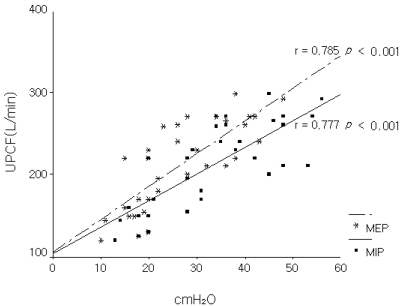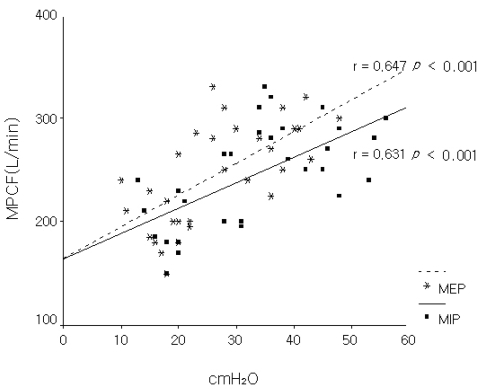Yonsei Med J.
2006 Apr;47(2):184-190. 10.3349/ymj.2006.47.2.184.
Respiratory Muscle Strength and Cough Capacity in Patients with Duchenne Muscular Dystrophy
- Affiliations
-
- 1Department of Physical Medicine and Rehabilitation, Rehabilitation Institute of Muscular Disease, Yongdong Severance Hospital Yonsei University College of Medicine, Seoul, Korea. kswoong@yumc.yonsei.ac.kr
- KMID: 1110740
- DOI: http://doi.org/10.3349/ymj.2006.47.2.184
Abstract
- The function of inspiratory muscles is crucial for effective cough as well as expiratory muscles in patients with Duchenne muscular dystrophy (DMD). However, there is no report on the correlation between cough and inspiratory muscle strength. To investigate the relationships of voluntary cough capacity, assisted cough techniques, and inspiratory muscle strength as well as expiratory muscle strength in patients with DMD (n=32). The vital capacity (VC), maximum insufflation capacity (MIC), maximal inspiratory pressure (MIP), and maximal expiratory pressure (MEP) were measured. Unassisted peak cough flow (UPCF) and three different techniques of assisted PCF were evaluated. The mean value of MICs (1918 +/- 586 mL) was higher than that of VCs (1474 +/- 632 mL) (p < 0.001). All three assisted cough methods showed significantly higher value than unassisted method (212 +/- 52 L/min) (F = 66.13, p < 0.001). Combined assisted cough technique (both manual and volume assisted PCF; 286 +/- 41 L/min) significantly exceeded manual assisted PCF (MPCF; 246 +/- 49 L/ min) and volume assisted PCF (VPCF; 252 +/- 45 L/min) (F = 66.13, p < 0.001). MIP (34 +/- 13 cmH2O) correlated significantly with both UPCF and all three assisted PCFs as well as MEP (27 +/- 10 cmH2O) (p < 0.001). Both MEP and MIP, which are the markers of respiratory muscle weakness, should be taken into account in the study of cough effectiveness.
Keyword
MeSH Terms
Figure
Cited by 2 articles
-
How Respiratory Muscle Strength Correlates with Cough Capacity in Patients with Respiratory Muscle Weakness
Jung Hyun Park, Seong-Woong Kang, Sang Chul Lee, Won Ah Choi, Dong Hyun Kim
Yonsei Med J. 2010;51(3):392-397. doi: 10.3349/ymj.2010.51.3.392.Analysis of Pulmonary Function Test in Korean Patients With Duchenne Muscular Dystrophy: Comparison of Foreign and Korean Reference Data
Tae Sik Bang, Woo Hyuk Choi, Sang Hun Kim, Je-Sang Lee, Soo-Yeon Kim, Myung Jun Shin, Yong Beom Shin
Ann Rehabil Med. 2016;40(5):851-861. doi: 10.5535/arm.2016.40.5.851.
Reference
-
1. Inkley SR, Oldenburg FC, Vignos PJ Jr. Pulmonary function in Duchenne muscular dystrophy related to stage of disease. Am J Med. 1974; 56:297–306. PMID: 4813648.
Article2. Lynn DJ, Woda RP, Mendell JR. Respiratory dysfunction in muscular dystrophy and other myopathies. Clin Chest Med. 1994; 15:661–674. PMID: 7867281.
Article3. Hahn A, Bach JR, Delaubier A, Rinardel-lrani A, Guillou C, Rideau Y. Clinical implications of maximal respiratory pressure determinations for individuals with Duchenne muscular dystrophy. Arch Phys Med Rehabil. 1997; 78:1–6. PMID: 9014949.
Article4. Bach JR, O'brien J, Krotenberg R, Alba AS. Management of end stage respiratory failure in Duchenne muscular dystrophy. Muscle Nerve. 1987; 10:177–182. PMID: 3547120.
Article5. Estenne M, Heilporn A, Delhez L, Yernault JC, De Troyer A. Chest wall stiffness in patients with chronic respiratory muscle weakness. Am Rev Respir Dis. 1983; 128:1002–1007. PMID: 6228174.6. Gibson GJ, Pride NB, Davis JN, Loh LC. Pulmonary mechanics in patients with respiratory muscle weakness. Am Rev Respir Dis. 1977; 115:389–395. PMID: 842952.7. Smith PE, Calverley PM, Edward RH, Evans GA, Campbell EJ. Practical problems in the respiratory care of patients with muscular dystrophy. N Engl J Med. 1987; 316:1197–1205. PMID: 3553943.
Article8. Bach JR, Rajaraman R, Ballanger F, Tzeng AC, Ishikawa Y, Kulessa R, et al. Neuromuscular ventilatory insufficiency: the effect of home mechanical ventilator use vs. oxygen therapy on pneumonia and hospitalization rates. Am J Phys Med Rehabil. 1998; 77:8–19. PMID: 9482374.9. Scanlan C, Myslinski MJ. Scanlan CL, Wilkins RL, Stoller JK, editors. Bronchial hygiene therapy. Egan's fundamentals of respiratory care. 1999. 3rd ed. St. Louis: Mosby;p. 792–793.10. Schramm CM. Current concepts of respiratory complications of neuromuscular disease in children. Curr Opin Pediatr. 2000; 12:203–207. PMID: 10836153.
Article11. Estenne M, Knoop C, Vanvaerenbergh J, Heilporn A, De Troyer A. The effect of pectoralis muscle training in tetraplegic subjects. Am Rev Respir Dis. 1989; 139:1218–1222. PMID: 2712449.
Article12. Linder SH. Functional electrical stimulation to enhance cough in quadriplegia. Chest. 1993; 103:166–169. PMID: 8417872.
Article13. Kang SW, Bach JR. Maximum insufflation capacity: vital capacity and cough flows in neuromuscular disease. Am J Phys Med Rehabil. 2000; 79:222–227. PMID: 10821306.14. Swinyard CA, Deaver GG, Greenspan L. Gradients of functional ability of importance in rehabilitation of patients with progressive muscular and neuromuscular diseases. Arch Phys Med Rehabil. 1957; 38:574–579. PMID: 13459572.15. Morris JF. Spirometry in the evaluation of pulmonary function. West J Med. 1976; 125:110–118. PMID: 969495.16. da Costa JL. Pulmonary function studies in healthy Chinese adults in Singapore. Am Rev Respir Dis. 1971; 104:128–131. PMID: 5556227.17. Wilson SH, Cooke NT, Edwards RH, Spiro SG. Predicted normal values for maximal respiratory pressures in Caucasian adults and children. Thorax. 1984; 39:535–538. PMID: 6463933.
Article18. McDonald CM, Abresch RT, Carter GT, Fowler WM Jr, Johnson Er, Kilmer DD, et al. Profiles of neuromuscular diseases: Duchenne muscular dystrophy. Am J Phys Med Rehabil. 1995; 74(Suppl 5):S70–S92. PMID: 7576424.19. Griggs RC, Donohoe KM, Utell MJ, Goldblatt D, Moxley RT 3rd. Evaluation of pulmonary function in neuromuscular disease. Arch Neurol. 1981; 38:9–12. PMID: 7458733.
Article20. Leith DE. Brain JD, Proctor D, Reid L, editors. Cough. Lung biology in health and disease. 1977. New York: Marcel Dekker;p. 545–592.21. Bach JR. Amyotrophic lateral sclerosis: predictors for prolongation of life by noninvasive respiratory aids. Arch Phys Med Rehabil. 1995; 76:828–832. PMID: 7668953.
Article22. Szeinberg A, Tabachnik E, Rashed N, McLaughlin FJ, England S, Bryan CA, et al. Cough capacity in patients with muscular dystrophy. Chest. 1988; 94:1232–1235. PMID: 3191765.
Article23. McCool FD, Tzelepis GE. Inspiratory muscle training in the patient with neuromuscular disease. Phys Ther. 1995; 75:1006–1014. PMID: 7480122.
Article24. Hadjikoutis S, Wiles CM, Eccles R. Cough in motor neuron disease: a review of mechanisms. QJM. 1999; 92:487–494. PMID: 10627867.
Article25. McCool FD, Leith DE. Pathophysiology of cough. Clin Chest Med. 1987; 8:189–195. PMID: 3621873.
Article26. Schmidt-Nowara WW, Altman AR. Atelectasis and neuromuscular respiratory failure. Chest. 1984; 85:792–795. PMID: 6723392.
Article27. Estenne M, De Troyer A. The effects of tetraplegia on chest wall statics. Am Rev Respir Dis. 1986; 134:121–124. PMID: 2942066.
- Full Text Links
- Actions
-
Cited
- CITED
-
- Close
- Share
- Similar articles
-
- A clinical study on Duchenne muscular dystrophy
- Clinical Implication of Sniff Nasal Inspiratory Pressure in Patients with Duchenne Muscular Dystrophy
- How Respiratory Muscle Strength Correlates with Cough Capacity in Patients with Respiratory Muscle Weakness
- Analysis of Pulmonary Mechanics and the Factors for Coughing in Duchenne Muscular Dystrophy
- Clinical Implications of Pulmonary Function Test and Maximum Static Pressure in Duchenne Muscular Dystrophy





